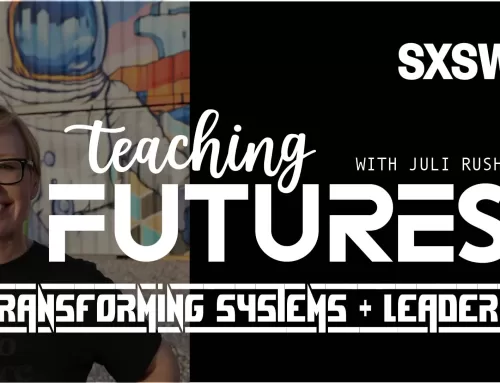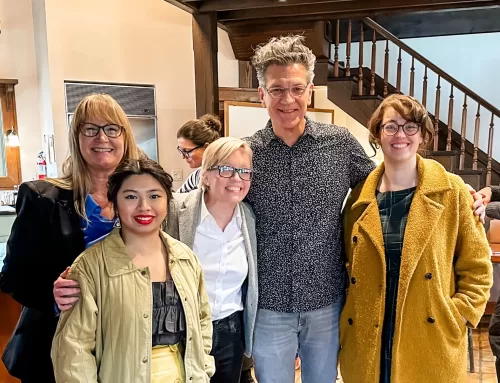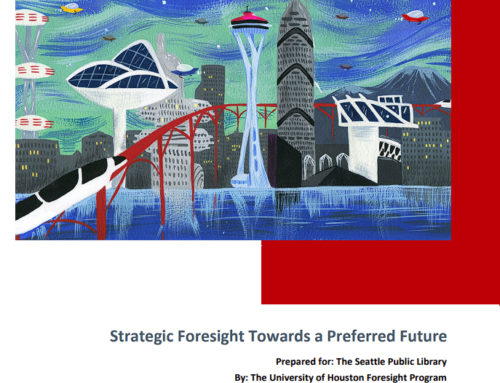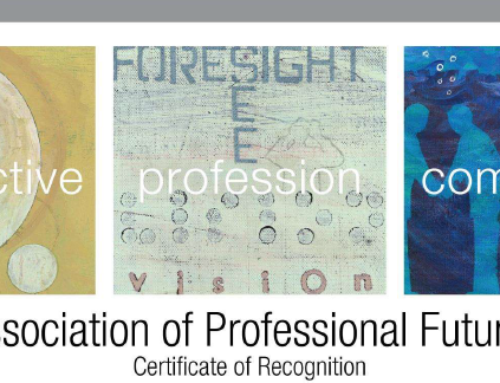In the Foresight ProSeminar class, students wrote a description of the foresight field for non-futurists suitable for publication in a mainstream newspaper or magazine. Here’s one student’s submission.
Contributor: Tyler Durden Denise Worrell

Image: Denise Worrell
1st RULE: You do not talk about predicting the future
Futurists do not predict the future; that’s impossible. Not even the world’s best predictive algorithms can predict the future. They can only suggest the likelihood of something happening—often in isolation of a single event or variable. As futurists, our job is to help leaders prepare for probable eventualities. If someone tells you they can predict the future, they are not a member of Foresight Club.
2nd RULE: You DO NOT talk about predicting the future
This one is so important that it bears repeating. DO NOT try to predict the future. Period.
3rd RULE: There are multiple alternative futures
It’s futurists’ job to help people map, understand, and navigate the alternative futures they have in front of them. And that idea—the idea that there are multiple futures is enormously powerful—and something most people are never taught to think about critically. So that’s what futurists are here to do. We systematically and creatively think about things that haven’t happened yet by scanning the environment and helping leaders begin to garden change by determining which seeds to water and what weeds to pull.
4th RULE: The future is not predestined
Always remember that you don’t have to accept the future that the system seems to have carved out for you. It’s up to you to consider the possible futures that lay ahead (for your business, for society, and yourself) and determine which you prefer. It’s hard to set a course for where you want to arrive until you consider what likely exists at the end of the possible paths you could take.
5th RULE: Technology is the future, but only in part
It’s easy to assume the future will be just like today, only with more and better technology. Although that’s likely true, it’s not the whole story. You should consider the role of technology in the future but in conjunction with a host of complex global systems, namely: social, economic, political, and environmental ones. Will climate change, societal demands for privacy, economic factors, political unrest, and cyberwars change the trajectory of how technology unfolds in the future? Yes, yes, yes, and yes (probably). The future is not a straight line, and you cannot assume the singularity or a world where machines do all the work while you work full time on your tan are the future.
6th RULE: Immerse people in the future, in the present
For most people, it’s far easier to remember the past than it is to imagine the future. It’s not that people aren’t smart enough to think about the future or don’t know what they want or need; it’s because, as humans, our frame of reference is based on our past and present experiences. Psychologically most people have a hard time relating to the future—it seems like something that will happen to someone else. To help people confront the future, you have to let them experience it in the present. By immersing people in a setting where they are personally confronted with the details of possible futures scenarios, you can help them make emotional connections by experiencing possible futures at both rational and emotional levels. When people get a chance to see and tangibly experience the future, it allows them to confront their neurological and cognitive biases—and the possible futures that they might otherwise dismiss because they couldn’t imagine or weren’t prepared to contemplate.
7th RULE: There are pockets of the future in the present
As a futurist, it’s important to look backward and see what trends and drivers are pushing us towards the baseline future that most people assume is coming. But it’s just as important, if not more so, to scan the horizon for those on the fringes of society toying with the future in the present. Sometimes these are industry leaders, scientists, or academics, but often, these game-changing ideas come from outsiders who see a problem, and a possible solution, by looking at a situation through a completely different frame. It’s not easy to find these fringe thinkers, but if you hone your skills to know where to look and learn to ask the right questions, you’ll discover those creating the future hiding in plain sight.
8th RULE: The future favors the bold
If you want to make an impact on how the future unfolds, you have to take the reins by designing a strategy that will steer your (or your business, or society) towards the preferred future you want to realize and away from possible alternative futures you wish to avoid. If you choose to sit back and wait to see what unfolds or stay too wrapped up in putting out the fires of today to give attention to where you want to be in ten years, the likelihood of reaching your ideal destination gets slimmer and slimmer. That’s true in funding your retirement, getting on a path to better health, and just about every other facet of your life. There’s no time like the present to take steps towards the future you wish to create.
About the Author
 Denise Worrell is a futurist, designer, and strategist who helps leaders envision their organizations’ ideal futures and then co-creates the experiences, strategies, and culture to make them real. She is a graduate of the Houston Foresight Masters program and has a passion for designing and realizing ideal future healthcare experiences.
Denise Worrell is a futurist, designer, and strategist who helps leaders envision their organizations’ ideal futures and then co-creates the experiences, strategies, and culture to make them real. She is a graduate of the Houston Foresight Masters program and has a passion for designing and realizing ideal future healthcare experiences.
LinkedIn: https://www.linkedin.com/in/denise-worrell-06384584/




